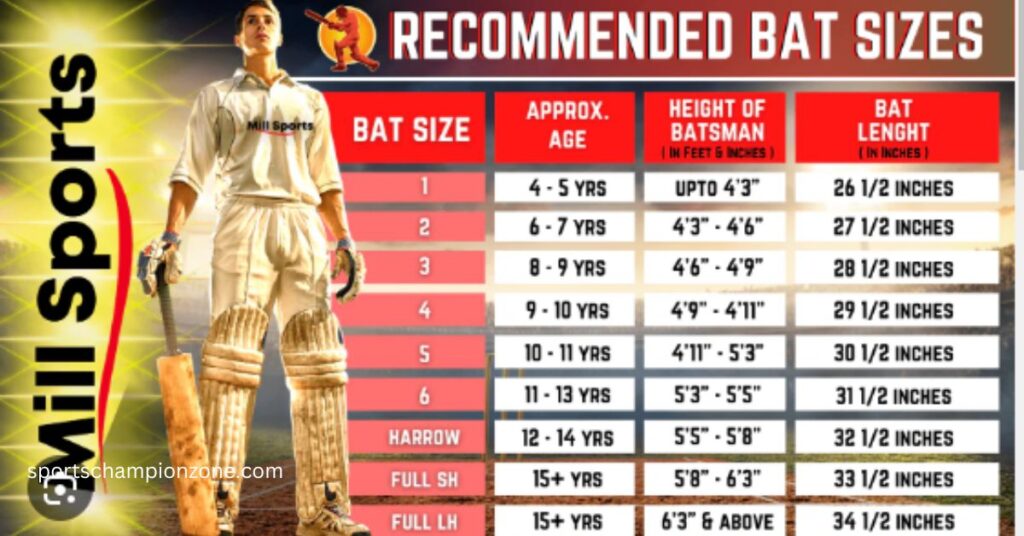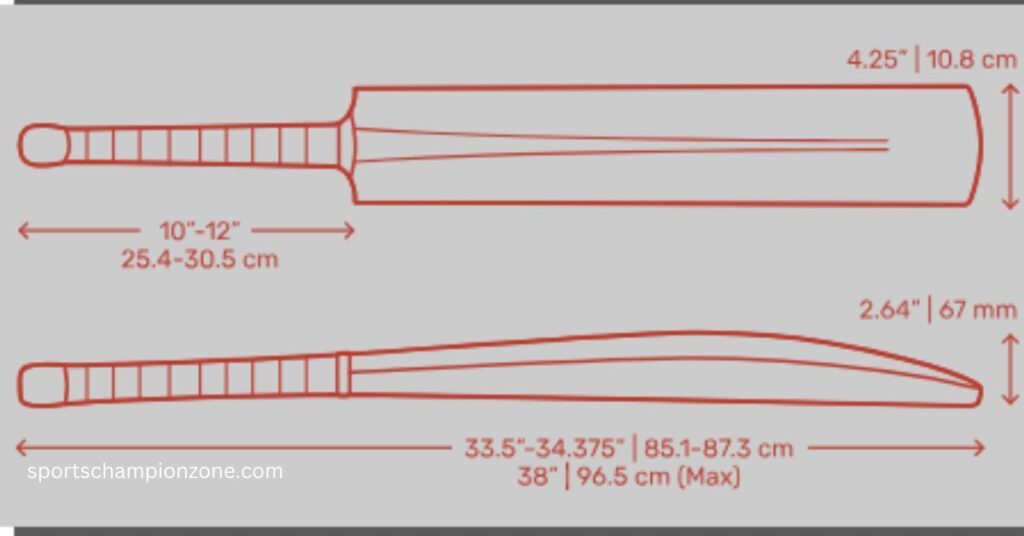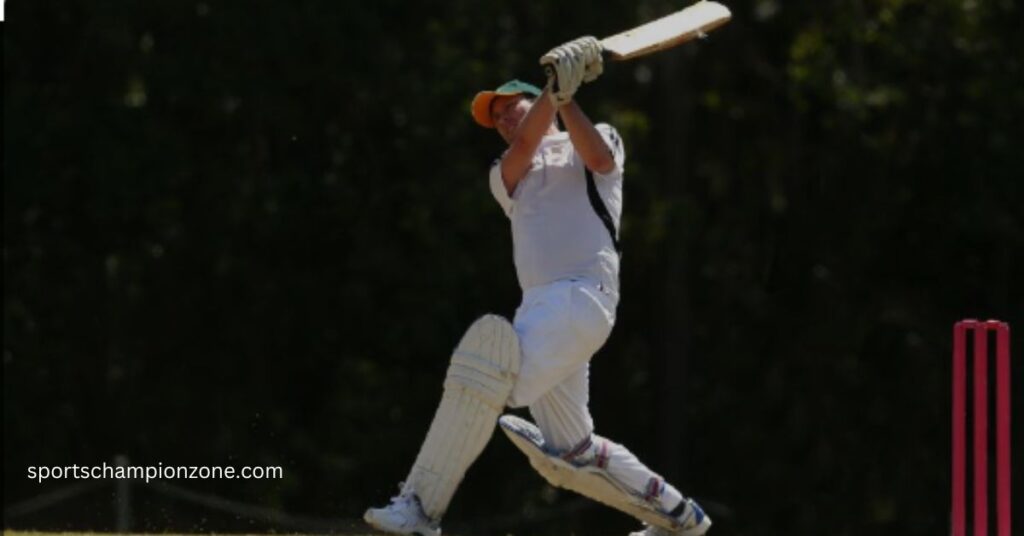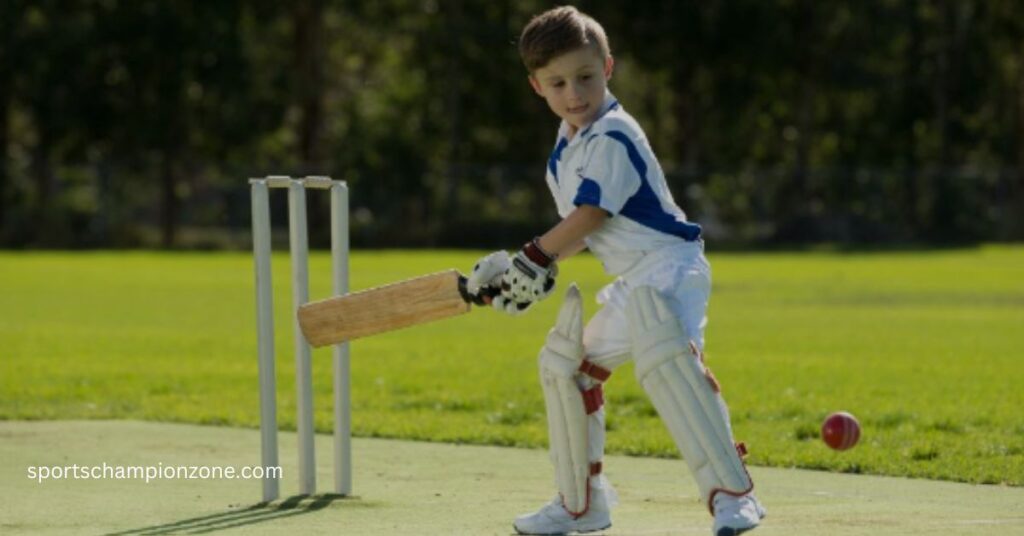The cricket bat in standard size is 28 to 36 inches. The cricket bat size in international leagues is 34 to 36 inches. From junior sizes like 1 and 2 for beginners to advancing to grown-up bats with sizes 5 and 6, find the ideal fit for your age and capacity level. Learn about the meaning of comfort, assessing strategies, and endeavoring before buying. The maximum weight of a cricket bat varies but typically falls between 2.5 to 3 pounds Whether it’s a Short Handle (SH) or Long Handle (LH) for senior players, understanding cricket bat sizes ensures ideal execution and enjoyment on the field.

Importance of Correct Bat Size
Choosing the right cricket bat size is like finding the right key to open a doorway—it’s principal! Here is the explanation:
1. Better Performance: Using a bat that is the right size for you can basically work on your show on the field. It thinks about better control, balance, and shot execution, helping you with playing your best game.
2. Comfort and Confidence: Batting with a precisely estimated bat feels like normal. It helps your affirmation and permits you to zero in on your game without obstruction.
3. Reduced Risk of Injury: Playing with a bat that is too significant or too light can provoke biomechanical issues and injury. Picking the right size reduces the amount of weight on your wrists, shoulders, and back.
4. Skill Development: For energetic players, using the right-sized bat is basic for acquiring fitting batting techniques from the beginning. It lays out the reason for capacity progression and development in the game.

Factors Affecting Bat Size Choice
A couple of factors become essential variables while concluding the ideal cricket bat size for a player. We ought to research:
1. Age and Physical Build: More energetic players generally use assessed bats, while adults use greater ones. Taller players could lean toward bats with longer handles for better reach and harmony.
2. Playing Style and Technique: Different bats are fit for various playing styles. Power hitters could incline in the direction of heavier bats with a lower wonderful equilibrium, while stroke players could pick lighter bats with a higher amazing equilibrium.
3. Experience Level: Beginners could benefit from using lighter bats with greater wonderful equilibrium, while state-of-the-art players could lean toward heavier bats for extended power and precision.
4. Personal Preference: The best bat size is the one that feels suitable for you. Factors like handle, weight movement, and manage shape can change between bat models, so it’s principal to assess different decisions and pick the one that suits you best.

Overview of Size Categories
Cricket bats come in various cricket bat size to oblige players of all ages and levels. Here is a rapid blueprint:
1. Junior Sizes (1-6): Junior bats are planned for young players, going from Size 1 for the most energetic to Gauge 6 for pre-youths.
2. Harrow: A moderate size among junior and senior bats, sensible for players aged 12–14.
3. Senior Sizes (SH, LH): Short Handle (SH) bats are the standard for adults, while Long Handle (LH) bats are specially designed for taller players.
Understanding these size arrangements is the most indispensable advance toward finding the ideal cricket bat size for your game. By considering factors like age, playing style, and individual tendency, you can seek out an informed decision and push ahead to the kink with assurance.
Junior Cricket Bat Sizes: A Guide For Young Players
Cricket, a sweetheart game played across the globe, requires the right equipment for developing players to encourage their capacities effectively. Among the principal gear, the cricket bat size stands separated as a fundamental instrument for batsmen. Understanding the fitting size of a cricket bat is basic for junior players to ensure comfort, control, and real strategy. Here is a deal-with manual for junior cricket bat size:

Size 1 and 2: The Beginning
Close to the start of their cricketing adventure, young players habitually start with Size 1 or Size 2 cricket bats. These bats are made with additional unassuming angles and lighter burdens, making them fitting for young people who are essentially starting to get to know the basics of batting.
The more cricket bat size licenses energetic players to manage the bat gently and swing it without perspiration, helping them encourage their coordination and technique starting from the start. Size 1 and Size 2 bats are ordinarily proposed for young people between the ages of 4 to 6, outfitting them with a solid basis to develop as they progress in the game.
Size 3 and 4: Stepping Up
As junior players create and obtain knowledge, they graduate to gauge 3 and size 4 cricket bats. These bats are insignificantly greater and heavier than Size 1 and Size 2 bats, offering young cricketers a touch more power and reach without overwhelming them.
Size 3 and Size 4 bats are fitting for youngsters aged 7 to 9, who have encouraged some capacity in batting and are wanting to refine their capacities further. With these barely greater bats, junior players can deal with causing a commotion in and out of town with extra control and exactness, setting them up for the hardships of serious cricket.
Size 5 and 6: Transitioning to Adult Bats
As young players approach their young years, they progress to Gauge 5 and Size 6 cricket bat size, which eagerly seem to be grown-up estimated bats concerning perspectives and weight. Size 5 bats are routinely endorsed for youngsters developed 10 to 12, while Size 6 bats are sensible for those developed 12 to 14.
These bats license junior players to experience batting with equipment that eagerly reflects what they will use in adult cricket, helping them to advance reliably as they advance in their cricketing adventure. Size 5 and Size 6 bats arrangement gives young cricketers the opportunity to refine their technique and conform to the nuances of using a standard bat preceding taking the leap toward grown-up cricket.
Senior Cricket Bat Sizes
Cricket bats come in various sizes to oblige players of different levels and tendencies. Understanding the decisions open is huge for senior players to pick a bat that suits their style and actual make-up. Here is a better manual for senior cricket bat sizes:
Short Handle (SH): The Standard Size
Short handle (SH) cricket bats are the standard size used by the majority of senior players. These bats are arranged with a handle of standard length and are sensible for most adults, regardless of what their level. SH bats recommend a fair amount of energy and are adequately adaptable to accommodate different batting styles. Whether you’re a major area of strength for an or a precision player, a short handle bat gives the control and power expected to prevail at the kink. This size is enjoyed by various senior cricketers in view of its shared traits and unlimited availability in cricket home improvement shops.
Long Handle (LH): Customized for Taller Players
For taller players who track down standard-sized bats off-kilter or restrictive, Long Handle (LH) cricket bats suggest a custom-fit plan. LH bats have an extensive handle, giving extra compass and impact to players with longer arms or taller levels. By picking a long-handled bat, taller players can achieve a more open batting position and show off the flaw. These bats are particularly productive for players who fight with the handle of a standard-sized bat feeling unreasonably short, allowing them to stay aware of real batting technique without settling.

Cricket Bat Size Material and Development
Cricket bat size, material, and improvement are fundamental factors influencing a player’s presentation on the field. Regularly, cricket bats are created utilizing willow wood, either English wood or Kashmir wood. English willow bats are seen as the top choice due to their common quality and execution, while Kashmir willow bats recommendation a more sensible decision without compromising a ton on quality.
The improvement of a cricket bat incorporates a couple of key parts. The sharp edge, or crucial body of the bat, is cut from a single piece of willow wood and features a level striking surface, known as the face. The back of the forefront may be imperceptibly curved to redesign power and balance. The edges of the forefront are regularly acclimated to reduce the odds of chipping or dividing upon impact with the ball.
The handle of the cricket bat is typically created utilizing stick or composite materials and is joined to the bleeding edge using a unit, which upholds the relationship between the two segments. The handle is wrapped with a grip to give the player a pleasant and secure hold during batting.

Care and Maintenance of Cricket Bats
Exactly when you first secure another cricket bat, it’s essential to set it up suitably before use to propel its show and strength.
1. Knocking-In: Preceding including your new bat in a game or work on gathering, it’s vital for “pounding in” the bat to pack the fibers of the willow wood, making it less leaned to hurt from impact with the ball. Use a remarkable bat hammer or an old cricket ball to tap the face and edges of the bat, logically extending the power more than a couple of gatherings carefully.
2. Oil Application: Oil Application layer of linseed to the face, edges, and toe of the bat. Grant the oil to ingest until further notice, then, at that point, clear off any excess with a fragile texture.
3. Edge Protection: Apply a protection edge tape to the edges of the bat to restrict the bet of damage from unintentional pounds and impacts during play.
Bat Maintenance Tips
At the point when your bat is prepared for use, standard help is essential to keeping it in top condition all through the season.
1. Capacity: Store your cricket bat in a cool, dry spot. Do whatever it takes not to leave it in the vehicle or introduced to crazy temperatures, as this can make the wood turn or break.
2. Cleaning: After every usage, wipe down your bat with a saturated texture to dispose of any dirt, sweat, or sogginess.
3. Grip Replacement: In case the grip on your bat becomes worn or perilous, supersede it with another to ensure a strong hold and optimal control during batting.
Repairing Minor Damages
No matter what your sincere endeavors, your cricket bat could sustain minor damages during play. Fortunately, various minor issues can be successfully fixed to extend the presence of your bat.
1. Surface Scratches: Use fine sandpaper to delicately sand away surface scratches or defects on the bat’s face and edges. Be careful so as not to sand too powerfully, as this can dispose of an over-the-top measure of wood and impact the bat’s presentation.
2. Cracked Edge: If the edge of your bat ends up being broken, apply a restricted amount of wood glue to the influence locale and carefully cut it together until the glue dries. At the point when dry, sand the decent district smooth and apply one more layer of edge tape for added confirmation.
How do you size a cricket bat?
For a cricket bat size, start by pondering your level and age. Measure yourself and imply assessing outlines given by makers. Hold the bat effectively, it isn’t exorbitantly extended or short to ensure the handle. Then, at that point, lead a swing test to conclude whether the weight and balance suit your fortitude and procedure.
How do I choose bat size?
To pick the right bat size, contemplate your level and age. Measure yourself by assessing the charts given by cricket equipment producers. Ensure the bat feels significantly better when held, with the handle not unnecessarily extensive or short. Direct several preparation swings to assess weight and harmony, ensuring they suit your fortitude and technique.
What is a full-size bat?
An ordinary cricket bat is expected for grown-up players and changes with the standard rules. It typically measures around 33 to 35 crawls in length and is made to meet express weight and width necessities set by cricket trained professionals. These bats are proper for players of ordinary level and build and give the key reach and power for ferocious play at grown-up levels.
What is the bat size of Virat Kohli?
Virat Kohli, one of cricket’s state-of-the-art legends, ordinarily uses a bat size that suits his playing style and tendencies. While clear assessments can move, Kohli typically chooses a bat that is barely more restricted than standard size bats, generally speaking, around 32 to 33 slithers long. This grants him the ability to stay aware of control and portability while at this point making tremendous power in his shots.
What is a bat grade?
Bat grade suggests the quality portrayal of a cricket bat, considering the materials used and the craftsmanship being referred to. Higher-grade bats are regularly made from premium willow, offering better execution and strength. They go through cautious handcrafting, achieving dominating harmony and responsiveness. Bat grade on a very basic level effects assessing, with higher-grade bats educating more prominent expenses as a result of their dominating quality and execution potential.
Conclusion
In conclusion, truly zeroing in on your cricket bat size is a major way to stay aware of its presentation and drag out its future. By following the means outlined in this assistant, you can ensure that your bat is suitably prepared for use, especially kept aware of all through the season, and expediently fixed expecting minor damages to occur.
From pounding in and oiling one more bat to typical cleaning and hold replacement, all aspects of bat care expect a fundamental part in smoothing out its durability and execution. By investing energy and effort into truly zeroing in on your cricket bat size, you can see the value in unexpected execution on the field and get generally outrageous value from your stuff for certain seasons to come.
If you want to more detail and better information about this you can also visit:
